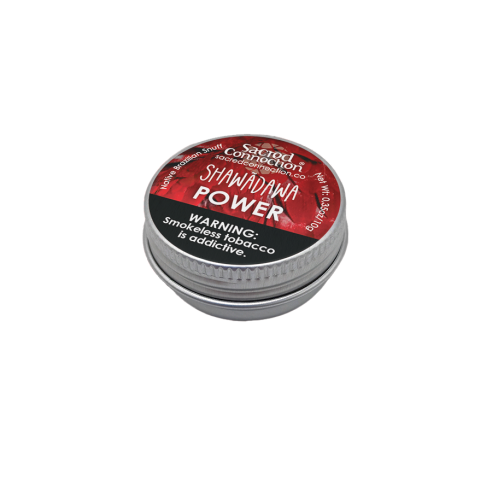Shawãdawa Rapé - Power
Shawãdawa Rapé - Power - 10gr
Shawãdawa Rapé - Power - 10gr - A Revitalizing Rapé Blend for Enhanced Energy
Discover Shawãdawa Rapé Power, a unique and invigorating rapé blend meticulously crafted under the influence of the full moon. This exceptional blend combines natural tobacco, Tsunu ash, and a traditional Shawãdawa medicinal herb known as Rawaputu, resulting in a powerful and rejuvenating rapé experience. Shawãdawa people have harnessed the potential of Rawaputu for generations, using it to combat various ailments such as headaches, flu symptoms, insomnia, mental disorders, and fatigue.
But Shawãdawa Rapé Power is not just about healing; it's also about providing strength and vitality. The Shawãdawa community relies on this special rapé to boost their energy levels for activities like fishing, hunting, and working in the fields. The best part? There's no need for a specific diet or preparation to enjoy its benefits. Shawãdawa Rapé Power is your daily companion to keep you energized and motivated.
More About Rapé
Rapé, a shamanic snuff widely found in the Amazon, has been a part of traditional Amazonian medicine and shamanic practices for centuries. Typically crafted with tobacco, it often contains various herbs and plants, adding unique flavors and purported medicinal properties to the mix. The strength of the rapé can vary depending on the blend used.
Traditionally, rapé is administered by a shaman through a pipe called a tepi, who gently blows small amounts of the rapé into the nostrils, delivering powerful and immediate effects. While you can also self-administer rapé using a kuripe pipe, it's important to note that receiving rapé from a shaman adds an extra layer of energetic healing and guidance.
Different cultural groups employ rapé in diverse ways. Some use it for its transformative properties or to enhance the effects of other plant medicines. It can also be used recreationally as a stimulant for physical labor, thanks to its reputed energy-boosting capabilities and potential cleansing effects on the body.
Please use rapé with care and respect, as it is a tobacco product and may be habit-forming.
The Arara Shawãdawa
The Arara Shawãdawa, like other indigenous groups in Acre, have faced challenges stemming from historical incursions driven by the rubber plantation industry in the late 19th century. They endured exploitation, expropriation, and cultural suppression during this period. However, recent years have witnessed a resurgence of their cultural identity, language, and efforts to reclaim their ancestral lands from the Brazilian state.
Although the Arara Shawãdawa initially adopted the name "Arara" during early contact with rubber plantation agents in the 19th century, they have always referred to themselves as Shawãdawa. Contact with the rubber industry profoundly impacted their native language, resulting in a decline in speakers. However, in recent decades, the Arara have actively worked to revive and transmit their language to younger generations.
Tradition and Rituals
Today, the elders play a vital role as the "guardians of the Arara memory," striving to pass down their cultural myths and rituals to the younger members of the community. There is a growing interest among the youth in learning the traditional practices that were prevalent in the past. While these rituals are not as frequent as before, some, like the mariri dance and the sinbu ritual, continue to be practiced, particularly to maintain the cohesion of the Arara Shawãdawa group and reinforce their cultural identity.
Ayahuasca and Kambo
The Arara Shawãdawa still practice rituals involving ayahuasca (liana) and kambo (frog) medicine. While most community members have participated in these rituals at some point, some no longer ingest ayahuasca, even if they have in the past. Traditionally, ayahuasca was used for various purposes, including healing, with shamans consuming it to treat illnesses and guide patients towards recovery.
The kambo ritual, aimed at restoring a hunter's luck, involves extracting the "milk" from a campo frog and applying it to the hunter's dogs. The hunter's skin is also lightly burned in specific areas, allowing the frog's milk to be introduced. The subsequent vomiting and evacuation are induced by consuming caissuma, a fermented manioc drink. After the ritual, the hunter is believed to regain essential qualities, such as improved aim, vision, hearing, and, most importantly, luck, to enhance their hunting skills.
In the words of Arara Chico Cazuza: "The injection is made when a person is weak. When he climbs these slopes, which we here call earth. When we stop climbing we get that buzzing in our heads, and our legs go weak. Then we take the frog's milk, the injection to make us improve. That cleans everything, what we are feeling, we get better."
Experience Shawãdawa Rapé Power, a blend steeped in tradition and designed to revitalize your energy and spirit.

